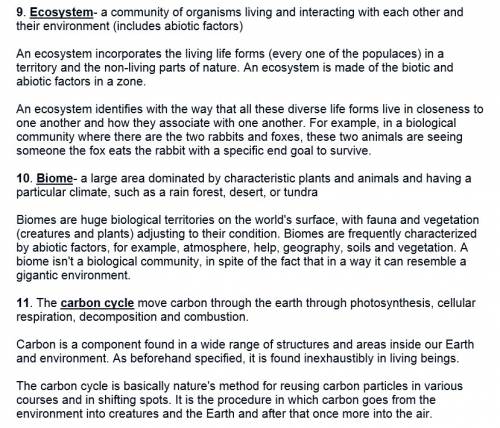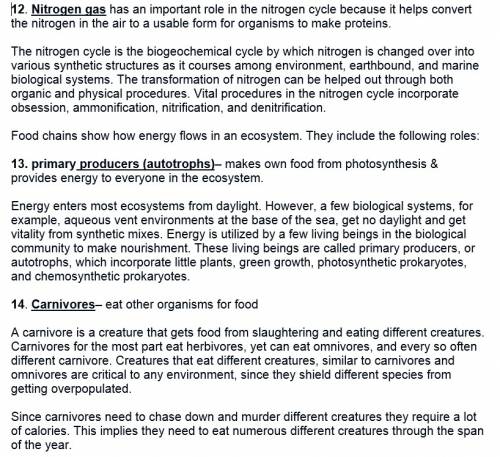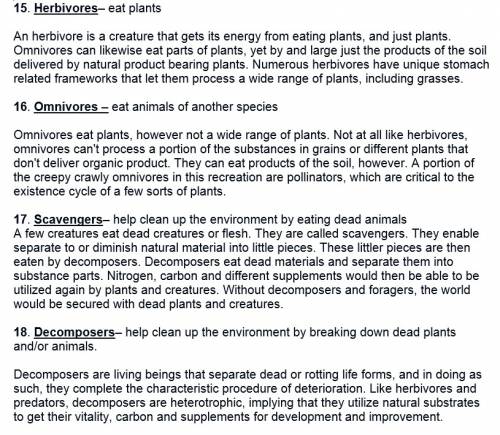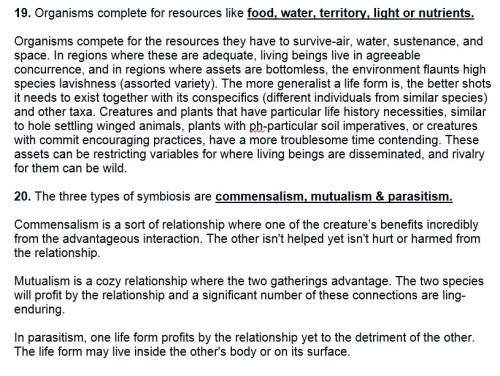 2
2 Please find the explanation below
Explanation:
Carbon cycle is the series of activities that utilize and release carbon from and into the atmosphere respectively. Carbon in the form of carbon dioxide (CO2) moves in and out of living organisms. In this case involving the fish (an animal) and an algae (a protist).
Fishes are animals, hence, they undergo RESPIRATION process to release carbon dioxide into the atmosphere as a waste product, hence, making C02 concentration in a water body increase. However, contrarily, algae are photosynthetic organisms that make use of carbon dioxide as a carbon source when undergoing the process of photosynthesis. Hence, they reduce the amount of C02 in the atmosphere.
Carbon is stored as biomass in every living organisms. For example, when the fish feeds on algae, it digests it and forms carbon compounds which get stored until they die and get decomposed, which release the stored carbon in them.
Fish produces C02 via the process of respiration respiration while algae uses the C02 via the process of photosynthesis.
 2
2 Please find the explanation below
Explanation:
Carbon cycle is the series of activities that utilize and release carbon from and into the atmosphere respectively. Carbon in the form of carbon dioxide (CO2) moves in and out of living organisms. In this case involving the fish (an animal) and an algae (a protist).
Fishes are animals, hence, they undergo RESPIRATION process to release carbon dioxide into the atmosphere as a waste product, hence, making C02 concentration in a water body increase. However, contrarily, algae are photosynthetic organisms that make use of carbon dioxide as a carbon source when undergoing the process of photosynthesis. Hence, they reduce the amount of C02 in the atmosphere.
Carbon is stored as biomass in every living organisms. For example, when the fish feeds on algae, it digests it and forms carbon compounds which get stored until they die and get decomposed, which release the stored carbon in them.
Fish produces C02 via the process of respiration respiration while algae uses the C02 via the process of photosynthesis.
 1
1 carbon
Explanation:
Carbon, hydrogen, oxygen, and nitrogen are the most important elements. Small quantities of other elements are necessary for life. Carbon is the most abundant element in living matter.
 1
1 carbon
Explanation:
Carbon, hydrogen, oxygen, and nitrogen are the most important elements. Small quantities of other elements are necessary for life. Carbon is the most abundant element in living matter.
 34
34 Carbon: is a versatile element, and the basis of all living organisms
Oxygen: is the most abundant element by mass
Hydrogen: makes up 60% of the atoms in living organisms
Explanation:
This is the correct answer in edg
 27
27  1
1 Explanation:
Homeostasis can be define as the tendency of the body to maintain it's environment constant and stable as compared to the changes occurring in the external environment.
a. The cardiovascular system will exchange gases such as carbon dioxide and oxygen with the body and the external environment. The main requirement of the body is the oxygen which is inhaled and the carbon dioxide is the gas which is produced as waste of the metabolic process which is exhaled out.
b. The muscle of the diaphragm contracts which allows the increase in volume of the thoracic cavity. The muscles helps in inhalation and exhalation. The intercostal muscles present between the ribs helps in enlargement of the chest cavity. They contracts the rib cage that helps in inhalation and when the rib cage expands the process results in exhalation. The inhalation process helps in maintaining the oxygen levels and exhalation maintains the carbon dioxide levels. Thus respiratory system maintains the homeostasis.
c. The cardiovascular system is the organ system that allows the circulation of the blood and transports nutrients like oxygen, carbon dioxide, blood cells, hormones, electrolytes and amino aids to and from the cells. Thus helps in maintaining the homeostasis by regulating the demands of the cells for oxygen and nourishment.
d. The lymphatic system is a network of small tubes called as lymph vessels. These vessels transfers the lymph fluid which transfers gases, white blood cells and nutrients throughout the body. Thus lymph system maintains the homeostasis by the fulfilling the demand of oxygen when body experience scarcity of oxygen.
 1
1 Explanation:
Homeostasis can be define as the tendency of the body to maintain it's environment constant and stable as compared to the changes occurring in the external environment.
a. The cardiovascular system will exchange gases such as carbon dioxide and oxygen with the body and the external environment. The main requirement of the body is the oxygen which is inhaled and the carbon dioxide is the gas which is produced as waste of the metabolic process which is exhaled out.
b. The muscle of the diaphragm contracts which allows the increase in volume of the thoracic cavity. The muscles helps in inhalation and exhalation. The intercostal muscles present between the ribs helps in enlargement of the chest cavity. They contracts the rib cage that helps in inhalation and when the rib cage expands the process results in exhalation. The inhalation process helps in maintaining the oxygen levels and exhalation maintains the carbon dioxide levels. Thus respiratory system maintains the homeostasis.
c. The cardiovascular system is the organ system that allows the circulation of the blood and transports nutrients like oxygen, carbon dioxide, blood cells, hormones, electrolytes and amino aids to and from the cells. Thus helps in maintaining the homeostasis by regulating the demands of the cells for oxygen and nourishment.
d. The lymphatic system is a network of small tubes called as lymph vessels. These vessels transfers the lymph fluid which transfers gases, white blood cells and nutrients throughout the body. Thus lymph system maintains the homeostasis by the fulfilling the demand of oxygen when body experience scarcity of oxygen.
 2
2 The carbon cycle is nature's way of reusing carbon atoms, which travel from the atmosphere into organisms in the Earth and then back into the atmosphere over and over again. Most carbon is stored in rocks and sediments, while the rest is stored in the ocean, atmosphere, and living organisms
Explanation:
1. "Homeostasis" is the tendency of an organism to regulate its internal conditions to maintain good health.
The biological meaning of homeostasis is "the propensity of a life form or cell to manage its inside condition and look after harmony, more often than not by an arrangement of criticism controls, in order to balance out health and functioning". By and large, the body is in homeostasis when its needs are met and its working legitimately.
Each organ in the body adds to homeostasis. An intricate arrangement of synthetic, warm, and neural elements collaborate in complex ways, both aiding and thwarting the body while it attempts to look after homeostasis.
2. "The body shivers" when you are cold & "the body sweats and pumps blood to the extremities" when you are hot are examples of homeostasis.
Shivering (likewise called shuddering) is a substantial capacity in light of chilly in warm-blooded creatures. At the point when the center body temperature drops, the shuddering reflex is activated to look after homeostasis. The body shudders when it is chilly, consumes more calories and moves blood profoundly of the body.
When you sweat, inhale vigorously and feel your heart beating, it doesn't simply mean you are having a decent exercise. These physiological variables are likewise imperative to your body keeping up a condition of homeostasis.
3. The basic needs of life are: solubility – to dissolve needed substances, oxygen and carbon dioxide– for respiration or photosynthesis , food (nutrition) – to provide energy, safety – shelter, temperature & space, modification – a change in the environment that causes an organism to change its activity.
Solubility is a concoction property alluding to the capacity for a given substance, the solute, to break down in a solvent . It is estimated as far as the greatest measure of solute disintegrated in a solvent at equilibrium.
Plants utilize carbon dioxide amid photosynthesis to create sugars and oxygen. Creatures and plants utilize oxygen in breath to deliver carbon dioxide. Every living creature plants and creatures do cell breath 24 hours per day.
4. Some changes take place inside an organism, which is called internal stimuli. (visual stimuli & touch are examples.) Others take place outside an organism; this is called external stimuli. (light & temperature are examples.)
There are two kinds of stimuli that influence the body: external and internal. External stimuli are changes to conditions outside of the body, or as a rule, data from outside the body that our faculties distinguish. For instance, our bodies react to changes in light and temperature and to wellsprings of peril.
Internal stimuli signals the condition of the body. A few precedents of Internal stimuli: visual stimuli, similar to the screen before you; snap of the keys; touch stimuli, similar to the vibe of the keys under your fingertips.
5. Behavior- the way an organism reacts to the stimulus (sneezes, moves, runs away, etc.)
Behavior refers to the manner in which a life form responds to change Stimulus – change in the living beings condition (can be inside or outside the life form's body) Response – response to the change Usually includes numerous body frameworks associating and cooperating or working together.
6. Biotic factors = living things (plants, animals, fungi, etc.) and abiotic factors = non-living things (rocks, water, temperature, etc.)
Abiotic factors allude to non-living physical and synthetic components in the biological system. Abiotic assets are typically gotten from the lithosphere, air, and hydrosphere. Precedents of abiotic factors are water, air, soil, daylight, and minerals.
Biotic factors are living or once-living life forms in the biological system. These are gotten from the biosphere and are fit for generation. Models of biotic components are creatures, fowls, plants, growths, and other comparable living beings.
Levels of Ecological Organization
7. Species- a group of individuals of the same species that exist together at a given place and time
A species is a gathering of individuals that are hereditarily related and can breed to create rich youthful. People are not individuals from similar species if their individuals can't deliver posterity that can likewise have youngsters. The second word in the two word name given to each creature is the species name. For instance, in Homo sapiens, sapiens is the species name.
8. Population - all of the populations living and interacting within a specific environment
A population is a gathering of living beings having a place with similar animal categories that live in a similar zone and interface with one another.Biological Population is a gathering of people of similar species living respectively in one place at one time. Biological Community includes every one of the populaces that live respectively in one region.





It will provide an instant answer!
